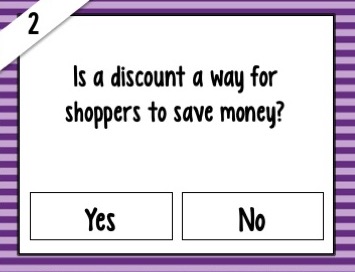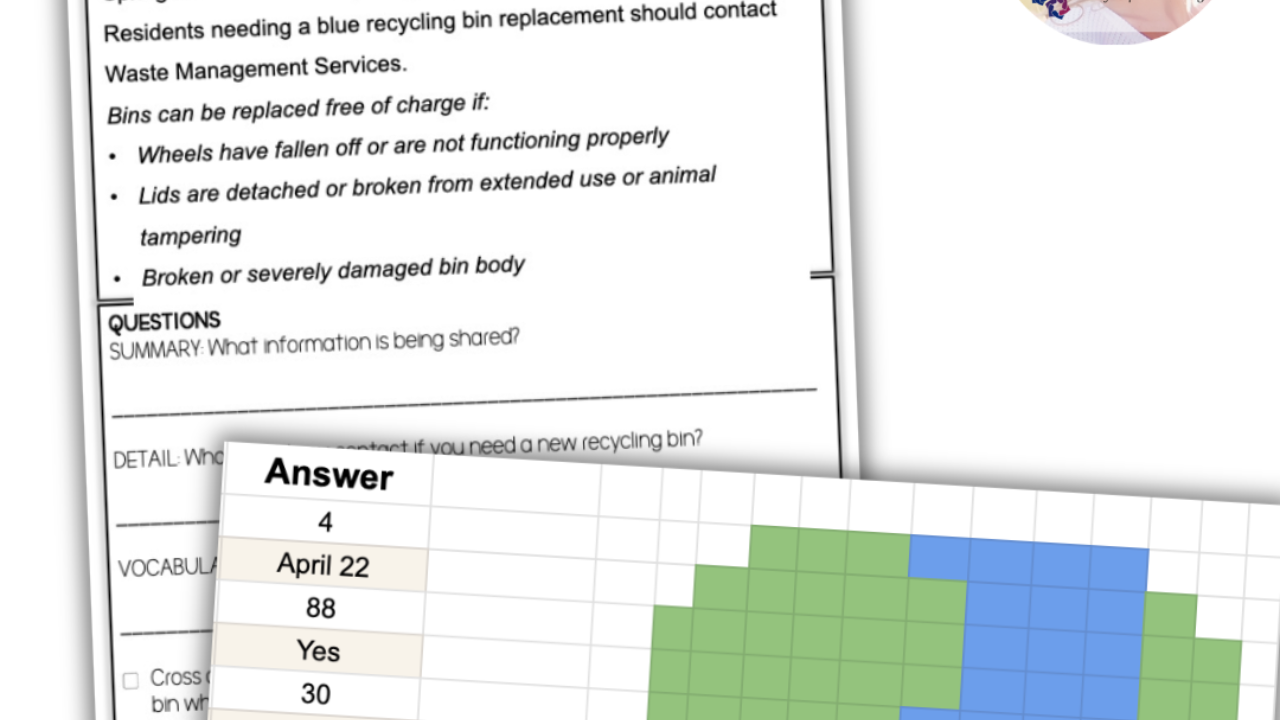Teaching Functional Money Math: Discount Lesson [Special Education]
Oct 03, 2020
Our next topic in the Consumer Math Blog Series is about how to teach Discounts. I'm sharing all about different types of discounts, important skills to cover when teaching Discounts, and the best resource for teaching discounts, my Discount Lesson Unit (click here to get your copy).
Purpose of Teaching about Discounts
I’m the first to admit I didn’t know what a BOGO was until I worked at Subway restaurant and had to have a seasoned employee show me how to put in discount codes when checking a customer out. I was about 16 or 17 years old. So, I consider it safe to say that while students may know that a discount makes a purchase price lower, they may not know the lingo or process for calculating the actual purchase price. That, in and of itself, is the purpose of teaching this important concept!
Money concepts and skills are real world skills. It's appropriate to begin teaching the concept of discounts and the skill of calculating discounts to students with special needs across a variety of grade levels, from middle school through high school, and especially young adults in transition.
Types of Discounts
% Off: When teaching math skills like discounts, this is often the go-to discount type that is covered. The big idea is that the higher the %, the lower the price. While this is the discount type that most students will encounter, there are other sale types listed below that a student would need to know how to approach to accurately calculate a total.
$ Off: Typical math problems that want to incorporate the use of real money dollar bills are typically $ off a total purchase-type discount. These are very common types of deals when shopping for items other than food.
BOGO: Buy One Get One deals include getting something for free or 50% off and can be seen when buying food and items in stores and online. This discount type easily lends itself to hands-on activities for practice, as there can be tactile method for teaching this type of discount.
Buy More Save More: Similar to $ Off, this includes $15 off a $30 purchase, so students need to understand that a coupon doesn't apply when a purchase total price moves into negative numbers. There may also be tiers to increase discounts the most a buyer spends, such as 15% off for totals over $100, 20% off for totals over $200, and 30% off for totals over $300.
Sitewide or Specific: Since most high school students have shopped online, they have probably visited an online store that is offering 15% off 'Sitewide', meaning everything (or nearly everything) that's sold on a website (or in a physical store) is on sale. They have probably also seen on websites or through email blasts from their favorite stores how only specific categories or types of items might be on sale. This might include just jeans, out-of-season clothes, or merchandise from a band's previous tour. Free Shipping deals may not apply to specific orders, including international, custom, or large, heavy orders.
Limited Time Only: Some offers are available until an item is sold out, but most are only available until a certain date.
Exclusions Apply: Discounts become true word problems because there is usually fine print. A buyer may only be able to purchase so many of a sale item, such as a limit of 10 cans of vegetables, when a specific brand is selling each can for $1. Sitewide sales may not include gift card purchases or apply to past purchases. The sale may only be accessed by certain people, like email subscribers or those with a promo code or physical coupon, or the first 25 customers.
Key-Must-Teach Concepts
A discount is worthless if the buyer doesn’t have the means to purchase it. No sale is worth it if you can’t afford it, and that means cash in hand.
25% = .25 and NOT 25. Being able to convert a percent to a decimal is the first step in calculating a discount and where most students get tripped up with the use of technology and what buttons/operations to press. Re-teach, reiterate and then review this step. This one step is the catalyst for the step-by-step progression of skills when calculating a discount without using technology apps.
5-Day Discount Math Lesson Unit
Save valuable prep time by grabbing this 5-day lesson unit for how to calculate % off discount skill.
Lesson Objective
Calculate the final cost of a bill with a discount applied.
What's Included:
- Lesson plans for 5 days worth of teaching for special education teachers
- % Off discount direct math instruction through notes and guided practice
- Consistent graphics across materials for visual learners
- Task Cards (Digital task cards through Boom Learning and Printable PDF)
- Fun activities for independent work based on real-world situations
- Different ways to include reading and writing (passage and prompts)
- Exit slip
- Assessment (2 levels)
- Answer keys
- Functional math skills practice
Lesson Unit Break Down
Day 1- Kick off the week with simple tasks, including the brain teaser and then layout the flow chart to show how discounts are a part of spending money (and ultimately a part of a budget). Then, keep it straightforward with the reading passage and subsequent materials. Read the passage as a class, dive into the writing prompts, and then end with the T/F questions. This T/F could serve as the exit slip, if you want to assess where the class is at.
Day 2—As you know by now, this day delves into the concepts through input (examples) and output (writing, i.e. notes). Repetition is a good thing, and visuals that complement the concepts help, too. Feel free to use the Exit Slip this day, day 3, or even day 4.
Day 3- The guided practice begins. This worksheet can be completed as a class, in small groups, partners, or independently, your choice! With 10 different scenarios, you could even start as a class with 2, move to small groups or partners for 3 more, then leave the last 5 for independent practice. This worksheet is solely focused on % discounts with round numbers, such as $119.00.
Day 4- As mentioned above, calculating % discounts is the most challenging ,and thus, the more practice ,the better. This day is dedicated to independent practice. Using the free PowerPoint in my store, students will work through calculating % discounts, subtotals, and totals. If your students are moving through this concept accurately, feel free to throw in a few of your own, such as a BOGO or Save $ on $.
Day 5- Use the task cards as one last review before the assessment. See the suggestion below. Then, the assessment will be passed out, and follow-up will be done with the word search and functional math review.
***If you want to switch up the word search, give them the word search for the concept you will cover the following week/day. This will get their mind introduced to the vocabulary without any demands.
If you want the class to work as a collective team and earn enough points as a group, then try this activity. Designate a ‘spokesperson,’ and perhaps choose a quieter leader or someone with less confidence or who may struggle with the concepts*. Then have the rest of the class move to the back of the classroom in a big group. Give the Spokesperson the question (verbally without the 2 answer options OR the actual card with the two options). That person will walk the question back to the big group, the class will decide as a group what the right answer is, give their ‘final answer’ to the spokesperson and then the spokesperson will walk it back and read it aloud to you. You could do the whole deck or give the class a goal of right answers (say 10 or 12) and once they hit that goal, move on to the next activity.
*The spokesperson may or may not participate in the group decision (which might be good if the topic was difficult for them), would have the opportunity to always answer correctly (hopefully), and could also show their peers they are confident and comfortable taking the lead (for those more quiet, reserved leaders).
Further Practice Idea
Looping back to the first Key-Must-Teach Concept, having a class discussion to solidify that even if a sale or discount or offer is amazing if a student doesn't have the budget to pay for the purchase OR have a true need, then no amount of discount is a 'good deal!'
Request some money from your department and go out on field trips to a local grocery store or restaurant, and do the discount calculations in real life, with the object in hand! You can do some pre-planning and search websites, social media, or newspapers for discounts to print or you can give each student a specific budget (see how I roped in another consumer math topic so smoothly), and let them spend it on anything that is on sale! Getting outside the classroom will help contextualize the skill as most students don't encounter opportunities to practice their discount skills naturally within a school day.
For example, this could mean buying 2 bottles of apple juice for $6.00 if the budget is $7.00, or grabbing a BOGO free ice cream bar, or a fruit smoothie flavor of the day that is 10% off. Be sure to stress that your receipt is proof of the discount used and the change received.
Ultimate Goal of the Lesson Unit
The ultimate goal is two-fold.
1st fold- What does the discount mean, and will it apply to my purchase? Meaning: Do I have two of the same product to get a BOGO? Have I spent enough money for $5 off $20? Does my Student ID get me 10% or 15% off this slice of pizza?
2nd fold- What steps do I follow to calculate the discount? Meaning: Is 10% .10 or .010? Do I subtract or add or multiply or divide?
Accurately achieving those two parts should mean 100% on that final assessment.
May I Also Suggest Teaching
If you are using a discount that means you are purchasing something, so go ahead and pair this lesson with Sales Tax, Budget Lesson Units, and skills to using Credit Cards and Debit Cards.
Looking for a year-long math curriculum of consumer math concepts? See if this my blog post to see if the Consumer Math Curriculum is right for you!
This lesson unit addresses the foundational skills of shopping and spending for life skills students who need to practice Comparing Prices when shopping, including checking for quality, quantity, and price.
For educators using the co-teaching model math teachers in a general education classroom, the Discount lesson unit may provide appropriate materials to supplement practice for individual students after the whole class lesson plan.






















